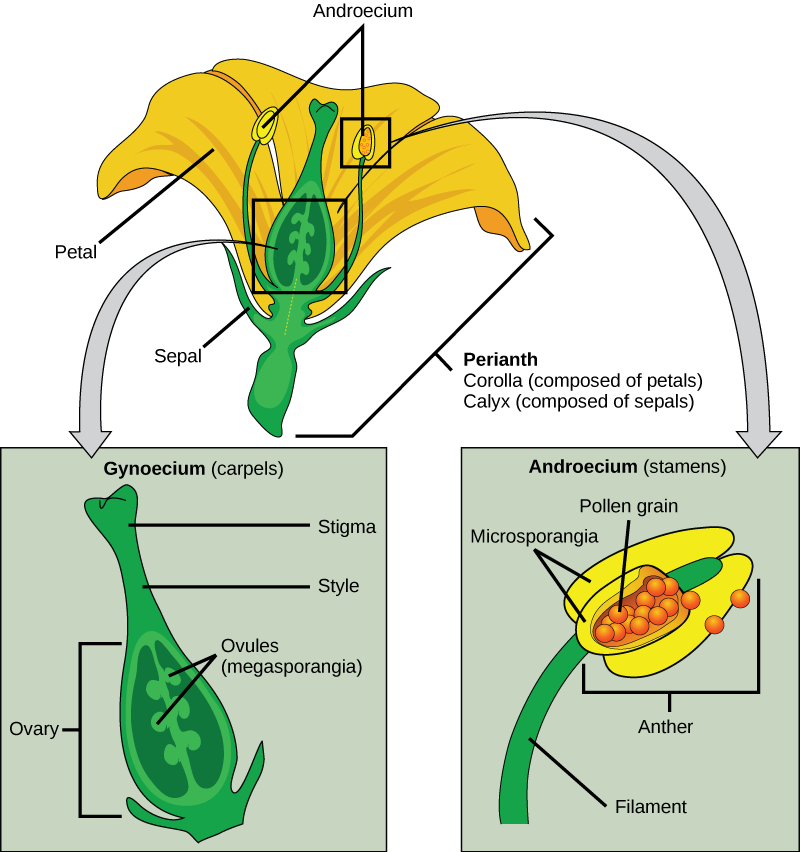
What are the sexual parts of the flower?
Answer
492k+ views
Hint: flowers are the reproductive organ of the plants, in angiosperms. They are brightly colored to attract insects that will help in the process of fertilization.
Complete step-by-step answer:

The part of the plant which bears seed is known as flowers, they have the reproductive organs that are surrounded by brightly colored petals and green sepals. Sexual parts of the flower can be divided into two categories- Male Reproductive Parts and Female Reproductive Parts.
Male Reproductive Parts (androecium)- It is also known as the stamen. It consists of a pollen sac which is also known as an anther and a long supporting filament. This filament helps in holding the anther in a position that helps in making the pollen available for dispersal by wind, insects, and birds.
Female Reproductive Parts (gynoecium)- It is also known as the pistil or carpel. The female reproductive parts consist of stigma, the style, and the ovary. Stigma is the top portion of the carpel and is very sticky that helps pollen grains during pollination. Style the middle portion ends into the ovary that contains ova or egg cells.
Note:
1. In angiosperms, pollination and fertilization are the two important stages in reproduction.
2. Flowers are used for many different purposes such as food production, source of honey, source of many different types of medicines, helps in pollination and crop yield, gives beauty to the surroundings, provides perfumes and scents, etc.
3. When the pollen from the male part of a plant transfers to a female part of a plant, later allowing it to fertilize, and the production of seeds, most often by an animal or by the wind.
Complete step-by-step answer:

The part of the plant which bears seed is known as flowers, they have the reproductive organs that are surrounded by brightly colored petals and green sepals. Sexual parts of the flower can be divided into two categories- Male Reproductive Parts and Female Reproductive Parts.
Male Reproductive Parts (androecium)- It is also known as the stamen. It consists of a pollen sac which is also known as an anther and a long supporting filament. This filament helps in holding the anther in a position that helps in making the pollen available for dispersal by wind, insects, and birds.
Female Reproductive Parts (gynoecium)- It is also known as the pistil or carpel. The female reproductive parts consist of stigma, the style, and the ovary. Stigma is the top portion of the carpel and is very sticky that helps pollen grains during pollination. Style the middle portion ends into the ovary that contains ova or egg cells.
Note:
1. In angiosperms, pollination and fertilization are the two important stages in reproduction.
2. Flowers are used for many different purposes such as food production, source of honey, source of many different types of medicines, helps in pollination and crop yield, gives beauty to the surroundings, provides perfumes and scents, etc.
3. When the pollen from the male part of a plant transfers to a female part of a plant, later allowing it to fertilize, and the production of seeds, most often by an animal or by the wind.
Recently Updated Pages
Master Class 9 General Knowledge: Engaging Questions & Answers for Success

Master Class 9 English: Engaging Questions & Answers for Success

Master Class 9 Science: Engaging Questions & Answers for Success

Master Class 9 Social Science: Engaging Questions & Answers for Success

Master Class 9 Maths: Engaging Questions & Answers for Success

Class 9 Question and Answer - Your Ultimate Solutions Guide

Trending doubts
State and prove Bernoullis theorem class 11 physics CBSE

What are Quantum numbers Explain the quantum number class 11 chemistry CBSE

Write the differences between monocot plants and dicot class 11 biology CBSE

Who built the Grand Trunk Road AChandragupta Maurya class 11 social science CBSE

1 ton equals to A 100 kg B 1000 kg C 10 kg D 10000 class 11 physics CBSE

State the laws of reflection of light




